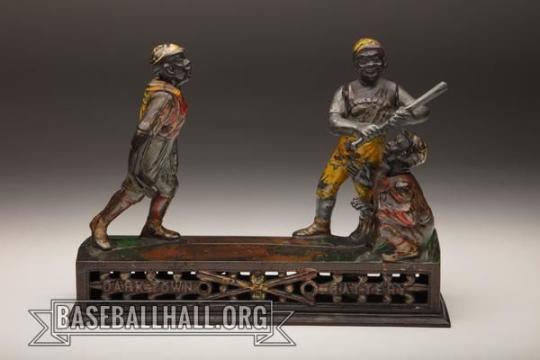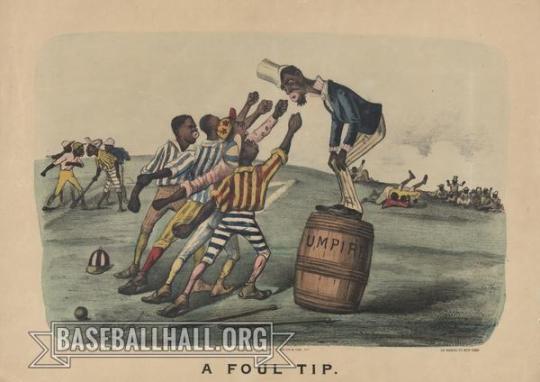- Home
- Our Stories
- #Shortstops: Dark Town Battery
#Shortstops: Dark Town Battery
On Feb. 3, 1870, the Fifteenth Amendment to the United States Constitution was passed.
This amendment forbade the denial or abridgment of the right to vote on account of race, color, or previous condition of servitude. Just weeks later, the first Black man to serve in Congress was seated. Hiram Rhodes Revels was selected by an 81-15 vote by the Mississippi State Senate to finish out the remainder of one of Mississippi’s U.S. Senate seats. This seat had been vacant since Albert Brown withdrew from the US Senate in 1861 – coinciding with Mississippi seceding from the Union.
A man of color sitting in the U.S. Senate and representing the people of a former member state of the Confederate States of America less than five years after the treaty of surrender being signed at Appomattox Courthouse may seem shocking to those not familiar with the story of Senator Revels. However, the story of Senator Revels is the perfect backdrop for the creation of a unique and sought-after mechanical bank.
Dark Town Battery is a mechanical bank collector’s dream. It has three characters, all of whom move. Mechanical banks that have three characters are rare, but one that has three moving characters is a truly rare design. The pitcher pitches a coin that has been placed in his right hand to a catcher that lifts his mitt, thus allowing the pitched coin to hit a flap on the catcher’s chest. This deposits the coin in the bank. While the pitcher and catcher (a battery) are performing these acts, the batter lifts his arms and his head moves as if he is watching an inside pitch go by.
This bank, designed by James H. Bowen, was patented and first produced in 1888 by J. & E. Stevens Company in Cromwell, Conn. – and is a piece of its time. Just 18 years after Hiram Revels sat in the U.S. Senate, this piece was produced.
Many historians of the U.S. Civil Rights Movements are familiar with the work of Harvard graduate, Dr. Rayford Logan. Logan stated that the Nadir Period (or the low point) for U.S. Race relations was between 1877 and 1901.
While there is debate among scholars over these dates, there is no question that in the late 1870s into the 1880s there was a noticeable shift in the view of the role of Black citizens in the United States.
This shift in racial views, from uneasy “acceptance” of a new social order to a full-out rejection, is most noticeable in baseball pop culture of the time. Currier and Ives is best known for creating images of rural Americana. From the mid-19th century to the early 20th century, these bucolic prints have become a cornerstone of American pop culture. However, beginning in the mid-1870s and continuing until the 1890s, Currier and Ives published the “Dark Town Comics.” These pieces were created mostly by artists Thomas Worth and James Cameron and were caricatures of both African Americans and the African-American experience.
Of the Dark Town Comics, two are currently on exhibit at the National Baseball Hall of Fame and Museum. These caricatured images, very similar to what we would today recognize as “Black Face,” are currently on display in the exhibit, Pride and Passion: The African American Baseball Experience. These two Currier and Ives prints, A Foul Tip (1882) and The Champions of the Ball Racket-At the Close of the Season (1885), both depict the players in a similar manner to the Dark Town Battery bank characters. Given the shared appearance and shared title, the bank clearly alludes to the popular prints of the time.
Some have argued the Dark Town series was done as a satire of “polite white behavior” at the time. But both today and at the time, these prints have been viewed as generally depicting Black ballplayers and African-American culture in a negative light. By examining the background of the term “Dark Town,” we are able to get a better understanding of both the political as well as social backdrop in which this bank was first cast. The bank itself is an impressive piece. The National Baseball Hall of Fame and Museum currently has three examples of Dark Town Battery in its collection. One is currently on display in the exhibit, Taking the Field: the 19th Century, while two others are currently in storage.
Dark Town Battery does come in several variations. One variation has the batter holding an oversized bat. Another variant has the batter wearing a white jersey, but the rarest of these versions, while still titled Dark Town Battery, has the players painted in a peachy flesh tone pigment. Given that all of the variations of this bank are highly sought after by collectors, it is not a surprise that reproductions have been made. However, many reproductions of the Dark Town Battery bank have been renamed “Hometown Battery.”
The only differences between the Dark Town and Hometown Batteries are the names that are visible on the side, and the paint color chosen to depict the players. While Dark Town depicts the players in a black paint, the Hometown players are depicted in the lighter skin tone. An original era and standard version of Dark Town Battery appeared in a 1997 episode of Antiques Roadshow. The bank was in great condition; the appraiser stated it was the “best Dark Town Battery I have ever seen” and appraised it at $15,000-$20,000. The show re-aired the item in 2012 with an increased value of $25,000. While Dark Town Battery is a piece that can be controversial given the historical background, the item remains relevant. It is an exemplary instance of American culture, politics, pop culture, race relations, and baseball, all coming together to show the complexity of this period in American history.
Nathan Tweedie is the manager of on-site learning at the National Baseball Hall of Fame and Museum







